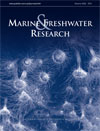Marine and Freshwater Research
Volume 65
Number 6 2014
Rapid changes in land-use and climate amplify the nutrient loadings along the land and coast continuum and severely impact the coastal biodiversity. In this article, the long-term variability in nutrients in correlation with land-use changes was analysed to demonstrate the status of water quality and biological indices in the Rappahannock River watershed. The results provide insight into changes in biogeochemical processes and interactions with biotic indices, which offer a key understanding to develop sustainable restoration plans for conservation and maintenance of coastal ecosystems in the Chesapeake Bay watershed.
We investigated the potential impact of the first proposed interstate translocation of mussel spat, for aquaculture enhancement, on Western Australian Mytilus populations. No detrimental genetic impact was identified that might warrant preventing the proposed translocation to WA. This study provides valuable genetic and biosecurity information, and should prove useful in future assessments of introduced and native Mytilus species in Australia.
Flooding in tropical river estuaries and deltas is often associated with mangrove mortality. We investigated how prolonged submergence at different salinities affected photosynthesis in seedlings of three common mangrove species and found that both duration of submergence and salinity of water affected photosynthetic performance. This finding is of importance for species- and site-specific restoration interventions because it is likely that mangrove areas experiencing prolonged submergence with saline waters will be more severely impacted than those flooded with freshwater.
Phragmites australis is a highly successful invader of wetlands worldwide and the ability to invade is due to the release of phytotoxins via various means, thereby causing adverse impacts on susceptible plants. Phytotoxicity investigation through residue decomposition of P. australis demonstrated that aeration condition, decay period and residue density play an important role in contributing to possible outcomes. The fitness-reducing effects of P. australis phytotoxins on associated plants enable P. australis to successfully invade wetlands.
The Tasman Sea is characterised by contrasted nutrient and phytoplankton distributions, offering a natural playfield to investigate nitrogen and iron limitation on phytoplankton growth – processes occurring in >50% of the ocean. This multidisciplinary study demonstrated that nitrogen and light were the main limiting factors in the North Tasman Sea and in the subantarctic zone, respectively. Iron and silicic acid could also limit part of the phytoplankton community, illustrating the complexity of nutrients limitation on natural assemblages.
A diverse tool kit of pest-fish control strategies are proposed in regional integrated control programs for common carp (Cyprinus carpio). Simulations of the carp population in a large river catchment (85 532 km2) were challenged with a range of existing removal methods and proposed biological controls. Virus-based bio-control, alone or in combination with genetically altered sex-ratios, was more likely to achieve targets of ecological damage reduction than reliance on removal methods alone.
Tropical marine ecosystems are increasingly being exposed to anthropogenic contamination, yet the suite of organisms currently available for toxicity test risk assessment lacks representative species from these environments. The present study demonstrated the sensitivity of the anemone Aiptasia pulchella to trace metals. Such research develops our understanding of the suitability of this species to represent the phylum Cnidaria in the framework of toxicity testing protocol.
Central Australia supports a number of relictual spring sites known to be biological hotspots and areas of high endemism. A comparison of faunal records collected over a 113-year period revealed the persistence of the aquatic invertebrate fauna. The high level of persistence found is likely due to multiple factors, including the relatively recent inclusion of many sites within national parks.




